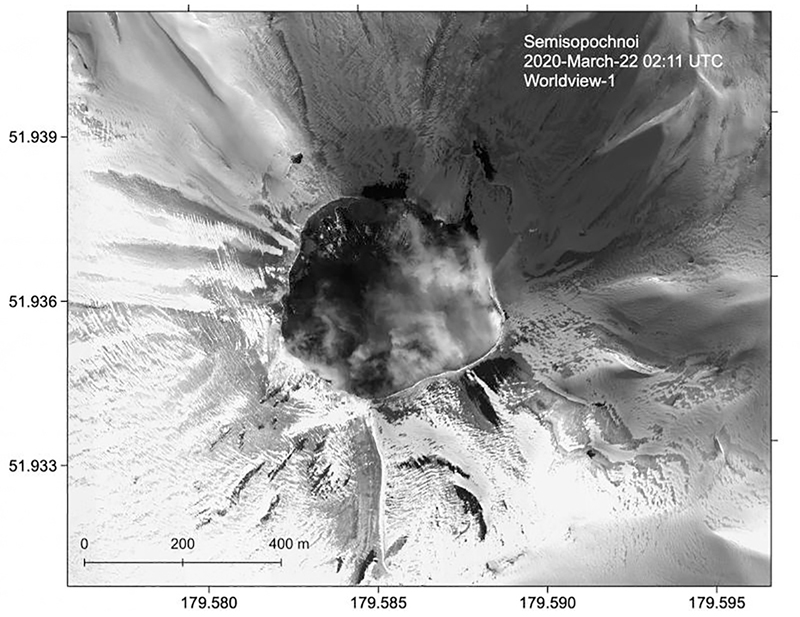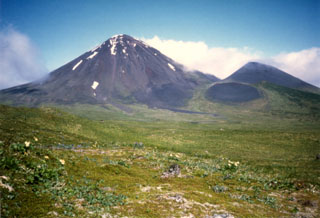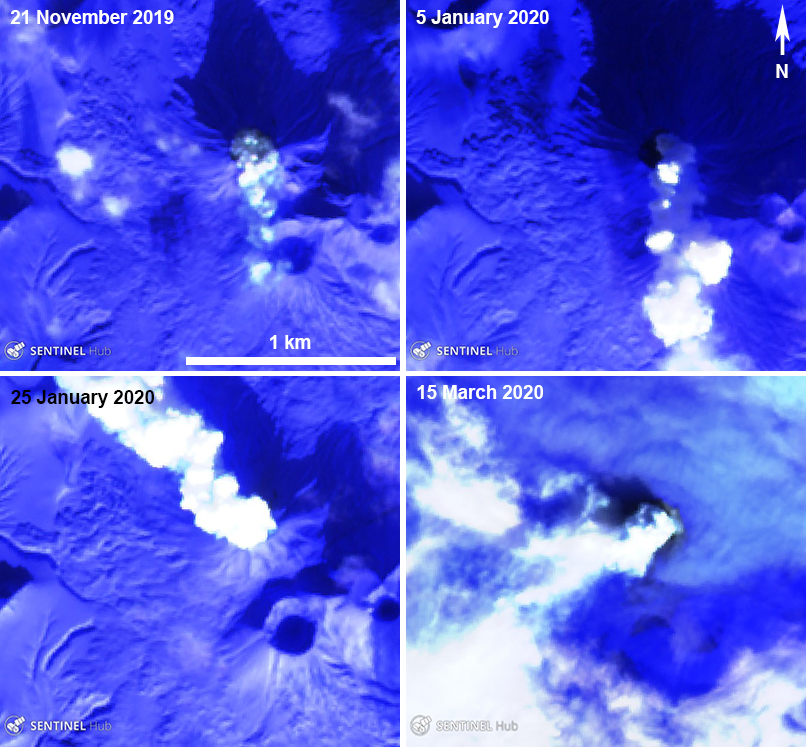Report on Semisopochnoi (United States) — April 2020
Bulletin of the Global Volcanism Network, vol. 45, no. 4 (April 2020)
Managing Editor: Edward Venzke.
Edited by Kadie L. Bennis.
Semisopochnoi (United States) Intermittent small explosions detected in December 2019 through mid-March 2020
Please cite this report as:
Global Volcanism Program, 2020. Report on Semisopochnoi (United States) (Bennis, K.L., and Venzke, E., eds.). Bulletin of the Global Volcanism Network, 45:4. Smithsonian Institution. https://doi.org/10.5479/si.GVP.BGVN202004-311060
Semisopochnoi
United States
51.93°N, 179.58°E; summit elev. 1221 m
All times are local (unless otherwise noted)
Semisopochnoi is a remote stratovolcano located in the western Aleutians dominated by an 8 km-wide caldera containing the small (100 m diameter) Fenner Lake and a three-cone cluster: a northern cone known as the North cone of Mount Cerberus, an eastern cone known as the East cone of Mount Cerberus, and a southern cone known as the South cone of Mount Cerberus. Previous volcanism has included small explosions, ash deposits, and gas-and-steam emissions. This report updates activity during September 2019 through March 2020 using information from the Alaska Volcano Observatory (AVO). A new eruptive period began on 7 December 2019 and continued until mid-March 2020 with activity primarily focused in the North cone of Mount Cerberus.
During September-November 2019, low levels of unrest were characterized by intermittent weeks of elevated seismicity and gas-and-steam plumes visible on 8 September, 7-8 October, and 24 November. On 6 October an SO2 plume was visible in satellite imagery, according to AVO.
Seismicity increased on 5 December and was described as a strong tremor through 7 December. This tremor was associated with a small eruption on 7 December; intermittent explosions occurred and continued into the night. Increased seismicity was recorded throughout the rest of the month while AVO registered small explosions during 11-19 December. On 11-12 December, a gas-and-steam plume possibly containing some of ash extended 80 km (figure 2). Two more ash plumes were observed on 14 and 17 December, the latter of which extended 15 km SE. Sentinel-2 satellite images show gas-and-steam plumes rising from the North Cerberus crater intermittently at the end of 2019 and into early 2020 (figure 3).
 |
Figure 2. Sentinel-2 satellite image showing a gray ash plume extending up to 17 km SE from the North Cerberus crater on 11 December 2019. Image taken by Hannah Dietterich; courtesy of AVO. |
The month of January 2020 was characterized by low levels of unrest due to intermittent low seismicity. Small explosions were reported during 14-17 February and a gas-and-steam plume was visible on 26 February. Seismic unrest occurred between 18 February-7 March. Gas-and-steam plumes were visible on 1, 9, 14-17, 20, and 21 March (figure 4). During 15-17 March, small explosions occurred, according to AVO. Additionally, clear satellite images showed gas-and-steam emissions and minor ash deposits around North Cerberus’ crater rim. After 17 March the explosions subsided and ash emissions were no longer observed. However, intermittent gas-and-steam emissions continued and seismicity remained elevated through the end of the month.
 |
Figure 4. Satellite image of Semisopochnoi showing degassing within the North Cerberus crater on 22 March 2020. Image taken by Matt Loewen; courtesy of AVO. |
Geological Summary. Semisopochnoi, the largest subaerial volcano of the western Aleutians, is 20 km wide at sea level and contains an 8-km-wide caldera. It formed as a result of collapse of a low-angle, dominantly basaltic volcano following the eruption of a large volume of dacitic pumice. The high point of the island is Anvil Peak, a double-peaked late-Pleistocene cone that forms much of the island's northern part. The three-peaked Mount Cerberus (renamed Mount Young in 2023) was constructed within the caldera during the Holocene. Each of the peaks contains a summit crater; lava flows on the N flank appear younger than those on the south side. Other post-caldera volcanoes include the symmetrical Sugarloaf Peak SSE of the caldera and Lakeshore Cone, a small cinder cone at the edge of Fenner Lake in the NE part of the caldera. Most documented eruptions have originated from Young, although Coats (1950) considered that both Sugarloaf and Lakeshore Cone could have been recently active.
Information Contacts: Alaska Volcano Observatory (AVO), a cooperative program of a) U.S. Geological Survey, 4200 University Drive, Anchorage, AK 99508-4667 USA (URL: https://avo.alaska.edu/), b) Geophysical Institute, University of Alaska, PO Box 757320, Fairbanks, AK 99775-7320, USA, and c) Alaska Division of Geological & Geophysical Surveys, 794 University Ave., Suite 200, Fairbanks, AK 99709, USA (URL: http://dggs.alaska.gov/); Sentinel Hub Playground (URL: https://www.sentinel-hub.com/explore/sentinel-playground).


